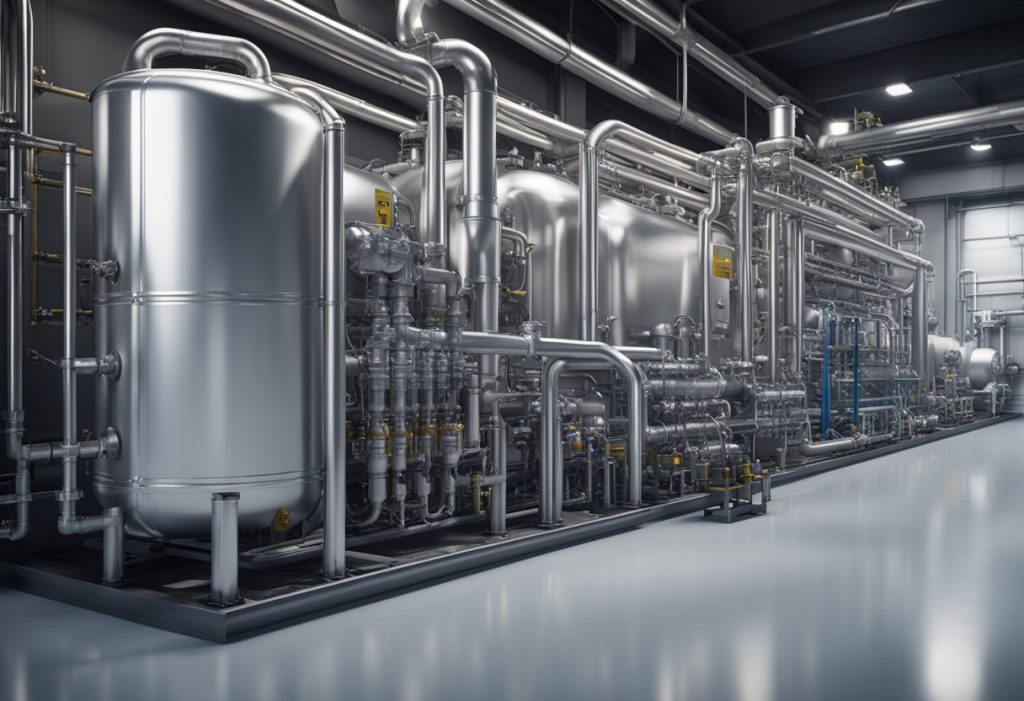Carbon dioxide (CO2) refrigeration is an evolving technology in the cooling industry with a spotlight on sustainability. As a natural refrigerant, CO2 is gaining notoriety for its low environmental impact compared to conventional refrigerants.
Its use in systems spans applications from industrial refrigeration to heat pumps and even automotive air conditioning. The properties of carbon dioxide, which include being non-toxic and non-flammable, contribute to its consideration as an environmentally friendly option, aligning with stricter regulations and a push towards greener alternatives.
Understanding CO2 refrigeration starts with grasping its fundamentals such as the thermodynamic characteristics that allow for efficient cooling processes.
The design of CO2 refrigeration systems involves unique components tailored to handle its high pressure and low critical temperature. Such systems, when optimized, may offer improved performance and efficiency. As you navigate the world of CO2 refrigeration training, you’ll encounter a range of systems and solutions that meet stringent environmental standards without compromising on cooling needs.
TL;DR:
- CO2 refrigeration represents a sustainable choice in the cooling sector, showcasing a move towards natural refrigerants.
- The design of CO2 systems includes specialized components to accommodate its distinct physical properties.
- Adopting CO2 refrigeration aligns with environmental regulations while maintaining efficiency and performance.
CO2 Refrigeration Fundamentals
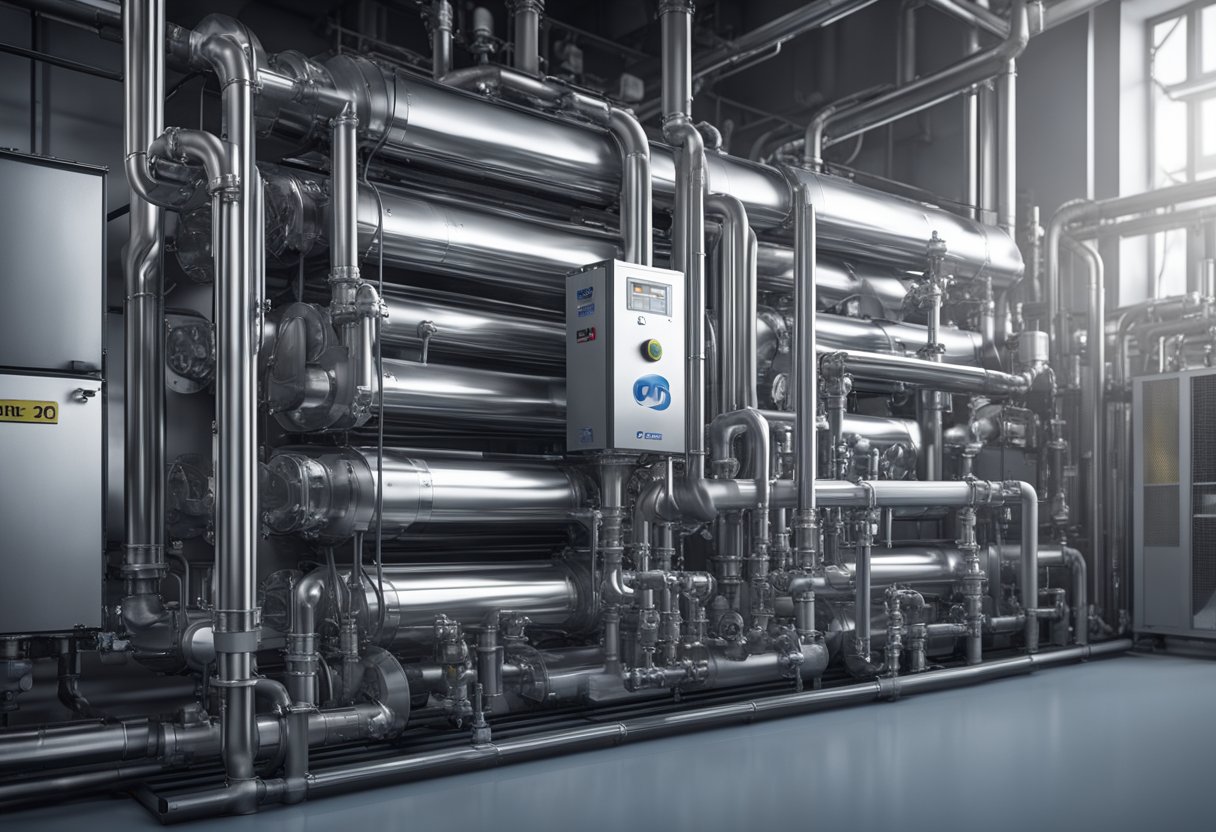
CO2 refrigeration utilizes carbon dioxide’s unique properties to provide efficient cooling solutions. Understanding the fundamental aspects of CO2 as a refrigerant is essential for designing and operating these systems effectively.
Properties of CO2
Carbon dioxide (CO2) stands out with a critical temperature of 31.1°C and a critical pressure of 73.8 bar, which implies that it becomes a fluid above these conditions, allowing it to efficiently absorb heat. The triple point of CO2 is at -56.6°C and 5.18 bar, where the substance can exist simultaneously as a solid, liquid, and gas.
This aspect necessitates careful handling to prevent CO2 from forming dry ice during system operation. High operating pressure is a characteristic of CO2 systems, which can exceed the critical point and operate in a transcritical state where traditional cooling cycle definitions do not apply.
Advantages of CO2 as Refrigerant
CO2 is non-flammable, making it a safer alternative to hydrofluorocarbon (HFC) refrigerants. It is also environmentally friendly with a global warming potential (GWP) of 1. Its high volumetric cooling capacity results in smaller system components compared to HFC systems. This can potentially lead to cost savings in terms of material and transportation. Additionally, CO2 refrigeration exhibits high energy efficiency in colder climates due to its thermodynamic properties.
Basic CO2 Refrigeration Cycle
The typical CO2 refrigeration cycle operates with a transcritical system, which differs from conventional cycles, especially when it operates above the critical point. At this stage, there is no distinction between liquid and gaseous CO2, and the system requires precise control of gas cooler pressure. A basic transcritical cycle comprises:
- Compression: Gas-phase CO2 is compressed to a supercritical state.
- Gas Cooling: Supercritical CO2 is cooled in the gas cooler, releasing heat to the environment.
- Expansion: The pressure is lowered, usually via an expansion valve.
- Evaporation: CO2 absorbs heat from the area to be cooled, transitioning from liquid to gas.
In some cases, a secondary coolant, like glycol, is used in conjunction with CO2, especially to reduce the risks associated with its high operating pressure. This combination also helps in maintaining system efficiency across various temperature ranges.
System Components and Design
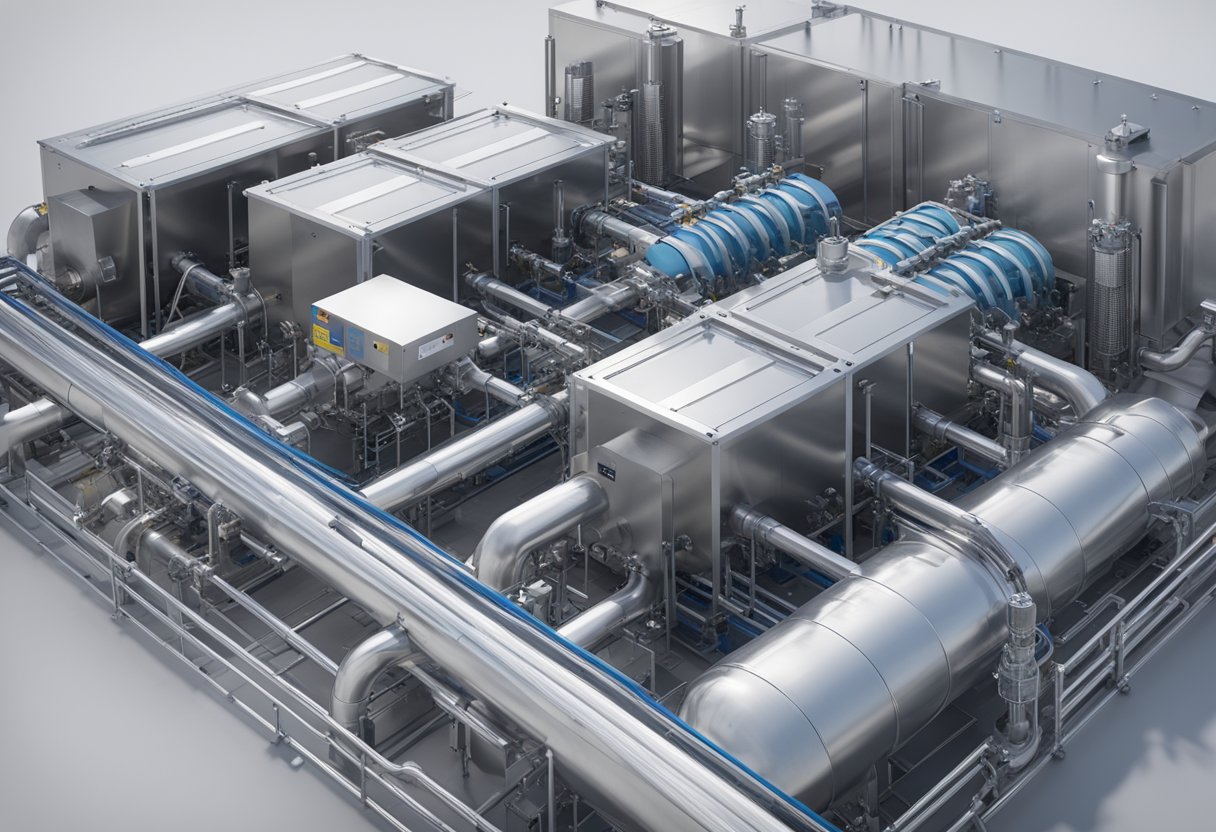
When exploring the realms of CO2 refrigeration, understanding the specific components that make up these systems is crucial. The design intricacies optimize the functionality and efficiency of the technology.
Main Components of CO2 Systems
Your CO2 refrigeration system hinges on several key components. The compressor, akin to the heart of the system, pressurizes CO2 to initiate the refrigeration cycle. Condensers or gas coolers are vital; they reduce the temperature of the pressurized CO2, leading to its condensation.
Evaporators then allow the liquid CO2 to expand and absorb heat from the environment, facilitating cooling. Expansion valves regulate refrigerant flow, while high-pressure control valves manage the CO2 pressure within safe operating levels. Each component’s design plays a pivotal role in maintaining the optimal pressure ratio and heat capacity essential for effective cooling.
Transcritical CO2 System Design
In contrast to traditional systems, transcritical CO2 refrigeration operates above CO2’s critical point. Here, you won’t find a phase change from gas to liquid during cooling, requiring a different architectural approach.
These systems often include a booster system, enhancing the efficiency of the pressure boosting process. Your design must also factor in the unique heat pump application, utilizing the transcritical cycle to provide heating solutions.
Heat Pump Application
The use of CO2 as a refrigerant extends into heat pump technology. A CO2 heat pump, employing a reverse refrigeration cycle, efficiently heats water by absorbing heat from the outside air.
This design leverages CO2’s excellent thermodynamic properties, yielding a system that’s both energy-efficient and environmentally friendly. When planning your heat pump, consider the specific interaction between components, such as the evaporators and gas coolers, to maximize heat transfer.
The components and design elements highlighted here are interdependent, and when carefully configured, contribute to a sophisticated CO2 refrigeration or heat pump system that addresses your need for advanced cooling and heating technology.
Performance and Efficiency
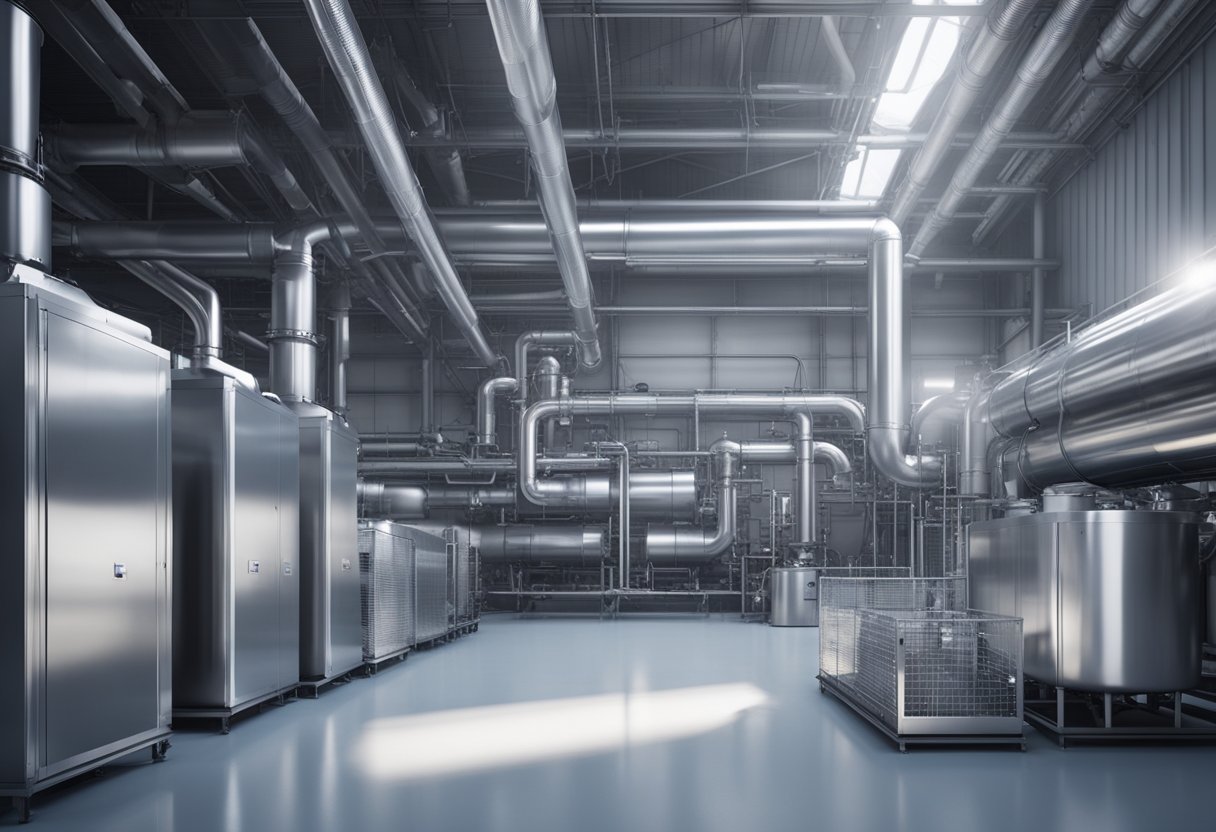
In assessing CO2 refrigeration, you’ll find performance and efficiency are closely tied to specific parameters, optimization strategies, and thorough maintenance protocols.
Energy Efficiency Parameters
The Coefficient of Performance (COP) of CO2 systems indicates their energy efficiency. You will observe that variations in COP are influenced by factors such as condensing temperatures: systems tend to be less efficient at higher temperatures.
The unique thermo-physical properties of CO2, when harnessed effectively, improve both energy and volumetric efficiency, mitigating some of the effects of temperature variations. For more insights into the relationship between condensing temperatures and system efficiency, you can read about the inherent properties of CO2 and how they influence refrigeration here.
Optimizing CO2 Systems
Optimizing your CO2 refrigeration setup is paramount for peak performance. Techniques like heat recovery can play a significant role in improving overall efficiency.
Proper design and implementation of ejectors can help to utilize expansion energy, which often increases the system’s efficiency and performance under a variety of operating conditions. These concepts are central to ensuring that your CO2 systems are operating at their maximum potential.
Maintenance and Operations
Regular maintenance is crucial for sustaining high efficiency levels in CO2 refrigeration systems. Proper monitoring of the equipment enables the early detection of leaks, which can significantly impact performance. You should also schedule routine cleaning of heat exchangers and coils to prevent efficiency losses.
Adhering to manufacturer guidelines for maintenance will help in upholding the integrity and longevity of your system. Considering the importance of continuous maintenance, detailed best practices can be found through resources such as Maximizing Efficiency in CO2 Refrigeration Systems – LinkedIn.
Environmental Impact and Regulations
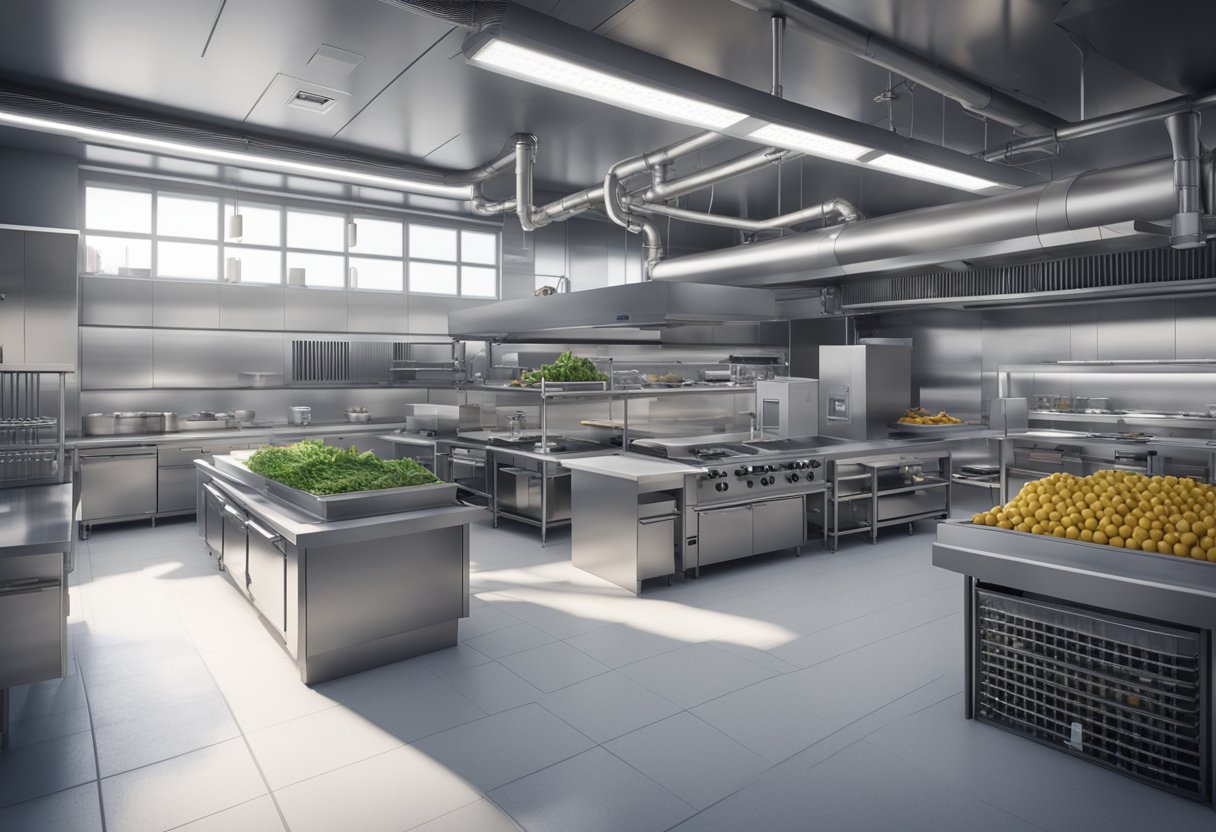
Understanding the environmental impact of refrigerants is crucial for sustainability. Your awareness of CO2’s role and the shifting regulatory landscape can guide you towards environmentally responsible choices in refrigeration.
CO2 and Global Warming Potential
CO2 refrigeration leverages carbon dioxide, a natural refrigerant with a Global Warming Potential (GWP) of 1, offering a significant environmental advantage over many synthetic refrigerants.
Unlike Hydrofluorocarbons (HFCs) or Chlorofluorocarbons (CFCs), CO2 does not contribute to ozone depletion potential (ODP) concerns, making it an attractive solution in efforts to limit greenhouse gas emissions.
Regulatory Landscape for Refrigerants
Regulations such as the Montreal Protocol and its amendments have successfully phased out substances with high ODP, like CFCs and HCFC refrigerants. More recent agreements, like the Kigali Amendment, aim to reduce HFCs due to their high GWP. These changes reflect a global commitment to environmental regulations that prioritize refrigerants with low global warming potential.
Future Outlook of CO2 Refrigeration
With stricter environmental regulations emerging, the shift towards natural refrigerants like CO2 is gaining momentum. Future outlook of CO2 refrigeration is expected to be positive as it aligns with both present and anticipated standards due to its low GWP and non-existent ODP. The use of CO2 may also pave the way for more sustainable cooling practices as industry standards evolve.
Frequently Asked Questions

In this section, you’ll find insight into the inner workings of CO2 refrigeration systems, which are becoming a popular choice due to their efficiency and environmental benefits.
How does a CO2 refrigeration system operate?
A CO2 refrigeration system operates by compressing and expanding carbon dioxide (CO2) to absorb and eject heat, respectively, in a cycle that can efficiently keep your goods at desired temperatures.
What are the typical pressures involved in a CO2 refrigeration system?
The pressures involved in a CO2 refrigeration system are significantly higher than those in traditional systems, with transcritical pressures often exceeding 100 bar (1450 psi) during operation.
What are the benefits of using CO2 as a refrigerant in cooling systems?
Using CO2 as a refrigerant offers benefits such as a lower overall operating cost, non-toxicity, and a negligible greenhouse gas effect, making it a sustainable choice for your refrigeration needs.
Can CO2 be utilized in transcritical refrigeration cycles, and if so, how?
CO2 can indeed be used in transcritical refrigeration cycles, where it operates above its critical point, allowing the system to function without a phase change, yielding high efficiency even at varying ambient temperatures.
What considerations must be taken into account when designing a CO2 refrigeration system?
Designing a CO2 refrigeration system requires accounting for its high operating pressures, the need for specific materials to handle the gas, and implementing proper safety measures due to the potential for rapid pressure increases.
How do CO2 refrigeration compressors differ from conventional refrigeration compressors?
CO2 refrigeration compressors are designed to handle the much higher pressures and have specialized lubricants to ensure smooth operation under the demanding conditions typical of CO2 systems.

